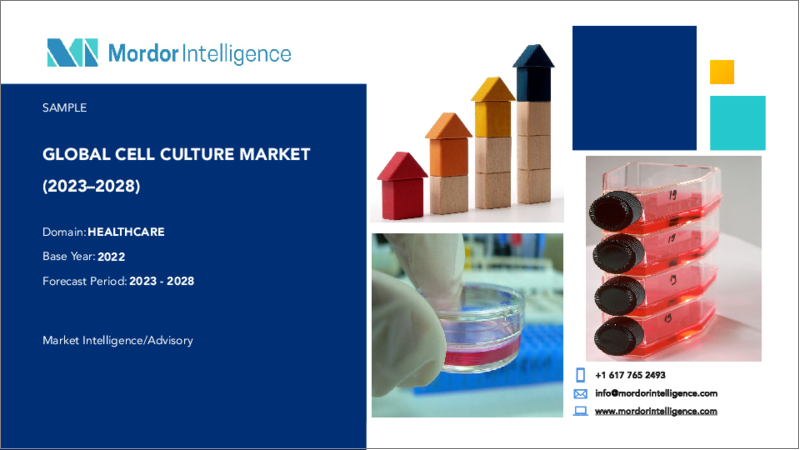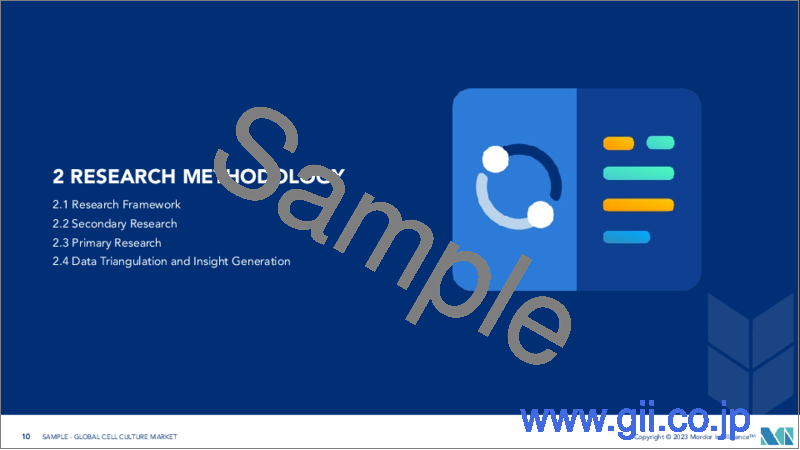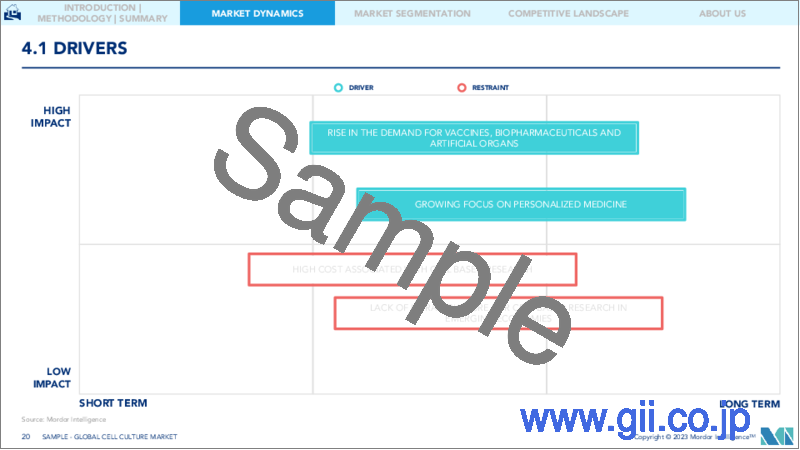|
|
市場調査レポート
商品コード
1190253
細胞培養市場- 成長、動向、予測(2023年-2028年)Cell Culture Market - Growth, Trends, and Forecasts (2023 - 2028) |
||||||
|
● お客様のご希望に応じて、既存データの加工や未掲載情報(例:国別セグメント)の追加などの対応が可能です。 詳細はお問い合わせください。 |
|||||||
| 細胞培養市場- 成長、動向、予測(2023年-2028年) |
|
出版日: 2023年01月18日
発行: Mordor Intelligence
ページ情報: 英文 115 Pages
納期: 2~3営業日
|
- 全表示
- 概要
- 目次
細胞培養市場は、予測期間(2022年~2027年)にCAGR11.0%で成長すると見込まれています。
COVID-19の発症に伴い、多くのバイオテクノロジー企業や製薬企業、各国の政府機関、研究機関が、この状況を打開するために有効なワクチンや新規治療薬の開発に注力し始めました。細胞培養は、COVID-19治療のための新規ワクチン開発のための潜在的なプラットフォームとして機能する可能性があります。さらに、このような方向性で市場関係者が行ったイニシアチブも、市場の成長に大きな影響を与えることになりました。例えば、2021年1月、Captivate Bioは、米国でCOVID-19やその他の新興疾患との戦いを支援するための細胞培養ツールのポートフォリオを発売しました。このように、COVID-19は市場の成長に顕著な影響を及ぼしました。
技術の進歩や製品・消耗品の発売と相まって、ワクチン、バイオ医薬品、人工臓器に対する需要の高まりと相まって、個別化医療に対する需要の高まりなどの主要な要因が、予測期間中の市場成長を促進しています。
GLOBOCAN Statisticsによると、2020年には世界中で1,930万人の新規がん患者が発生したと推定され、2040年には3,020万人に達すると予測されています。このようながんの増加は、精密医療の必要性を生み、個別化医療の発展において細胞培養が重要な役割を果たすことから、今後数年間で細胞培養の需要が増加すると予想されます。さらに、医薬品やバイオ医薬品の研究開発の活発化も、市場の成長に大きく寄与しています。例えば、欧州製薬団体連合会の2022年版レポートによると、欧州の製薬業界は研究開発のために396億5,600万ユーロの費用を負担しており、2022年にはこの費用が415億ユーロになると予想されています。このような研究開発への注力の高まりは、薬剤の有効性を試験するための細胞培養の必要性を生み出し、市場の成長を後押ししています。
また、製品の発売も市場の成長を後押しすると予想されます。例えば、2021年3月、サーモフィッシャーサイエンティフィックは、新製品「Gibco Human Plasma-like Medium(HPLM)」を発売しました。これは、ヒト血漿の代謝プロファイルを模倣した最初のタイプの細胞培養液の1つで、研究者に人体内の細胞増殖のリアルな様子を提供するよう設計されています。
さらに、技術的に高度で革新的な製品の発売も、市場の成長を後押ししています。例えば、2022年2月、Nucleus BiologicsはKrakatoaを発売しました。これは、研究者が使用する時点で細胞培養培地を製造するのに役立つ、革新的で市場初の培地メーカーの1つです。
したがって、上記の要因によって、細胞培養市場は予測期間中にかなりの成長を示すと予想されます。しかし、細胞培養研究に関連する高いコストと、新興国における細胞培養研究のためのインフラの欠如が、市場の成長を阻害する可能性があります。
主な市場動向
医薬品開発セグメントは予測期間中に急速な成長を遂げると予想されます。
細胞培養は、医学研究および創薬に不可欠な要素です。医薬品開発は、ターゲットの特定からリードの発見と最適化、前臨床検証、臨床試験、そして臨床使用の承認に至るまで、複数の段階で完了する、時間とコストのかかる手順です。細胞ベースのハイスループットスクリーニング(HTS)は、現在、組織培養に最適化されたプラスチック表面上で2次元(2D)に増殖させた培養細胞で実施されています。3次元細胞培養の出現により、HTSのプロセスはより容易かつ正確になってきています。
さらに、創薬のための各国政府からの支援も、このセグメントの成長に寄与しています。例えば、2020年7月、インド連邦政府は、創薬ハッカソン「Nishank」を開始しました。このハッカソンは、創薬プロセスを支援するための初の国家的な取り組みであり、市場関係者だけでなく、さまざまな省庁からも支援を受けています。
さらに、市場参入企業による取り組みも、市場セグメントの成長を後押しすると予想されます。例えば、2021年11月、メルクはGIイノベーションと覚書(MoU)を締結し、韓国における生物医学の開発を促進しました。MoUに基づき、メルクはCHOZNプラットフォーム、細胞培養培地、下流プロセス開発などの技術やサービスを提供し、生命を救う重要ながん治療薬やアレルギー関連疾患の治療薬の研究開発を促進します。このような取り組みも、本セグメントの成長に寄与しています。
このように、上記の要因により、同市場は予測期間中に大きな成長を遂げると予想されます。
予測期間中、北米が細胞培養の世界市場を独占
北米は現在、細胞培養市場を独占しており、予測期間中も同じ傾向をたどることが予想されます。これは主に、ワクチン、バイオ医薬品、人工臓器の需要増と相まって個別化医療の需要が高まっていること、および市場における主要企業の存在に起因しています。
米国がん協会の2022年の統計によると、米国では2022年に新たに1,918,030件のがん患者が発生すると推定されています。このようながんなどの疾病の負担増は、精密医療の必要性を生み出し、その開発のための細胞培養製品および消耗品の需要増につながり、市場の成長を牽引しています。
また、市場参入企業による製品の発売も、市場の成長を後押しすると予想されます。例えば、2020年12月、eNuvio Canada社は、最初の完全に再利用可能な3D細胞培養マイクロプレートの1つ、すなわちEB-Plateを発売しました。このような発売は、同地域の市場の成長を促進すると期待されます。さらに、2022年2月、KromaTiDは、細胞および血液培養の成長、分離、処理、および品質管理サービスの包括的なスイートを開始しました。各社によるこのような製品やサービスの発売は、細胞培養製品や消耗品の需要も押し上げるため、市場の成長を促進することが期待されます。
このように、北米地域の細胞培養市場は、上記のような要因により、予測期間中に大きな成長を見せると予想されます。
競合情勢
細胞培養市場は適度な競争下にあり、複数の大手企業で構成されています。市場シェアの観点からは、現在、少数の大手企業が市場を独占しています。Thermo Fisher Scientific、Danaher Corporation、Sartorius AG、Merck KGaAなどの主要な市場プレイヤーの存在も、市場全体の競争企業間の敵対関係を高めています。さらに、主要プレイヤーによる製品の進歩や細胞培養プラットフォームの改良も、競争を激化させています。
その他の特典です。
- エクセル形式の市場予測(ME)シート
- アナリストによる3ヶ月間のサポート
目次
第1章 イントロダクション
- 調査の前提条件と市場の定義
- 調査対象範囲
第2章 調査手法
第3章 エグゼクティブサマリー
第4章 市場力学
- 市場概要
- 市場促進要因
- ワクチン、バイオ医薬品、人工臓器に対する需要の高まり
- 個別化医療への注目の高まり
- 市場抑制要因
- 細胞ベースの研究に関連する高コスト
- 新興国における細胞ベース研究のためのインフラ不足
- 業界の魅力- ポーターのファイブフォース分析
- 買い手/消費者の交渉力
- 供給企業の交渉力
- 新規参入業者の脅威
- 代替品の脅威
- 競争企業間の敵対関係
第5章 市場セグメンテーション(金額ベース市場規模:100万米ドル)
- 製品・消耗品別
- 製品別
- バイオセーフティ機器
- 遠心分離機
- 冷凍保存装置
- 培養システム/バイオリアクター
- インキュベーター
- ピペッティング機器
- その他
- 消耗品
- 培地
- 血清
- 試薬
- 製品別
- アプリケーション別
- バイオ医薬品
- 医薬品開発
- 遺伝子治療
- 組織培養・工学
- ワクチン製造
- その他の用途
- 地域別
- 北米
- 米国
- カナダ
- メキシコ
- 欧州
- ドイツ
- 英国
- フランス
- イタリア
- スペイン
- その他の欧州地域
- アジア太平洋地域
- 中国
- 日本
- インド
- オーストラリア
- 韓国
- その他アジア太平洋地域
- 中東・アフリカ地域
- GCC
- 南アフリカ
- その他中東地域
- 南米地域
- ブラジル
- アルゼンチン
- その他の南米地域
- 北米
第6章 競合情勢
- 企業プロファイル
- Biospherix
- Hi-Media Laboratories
- Merck KGaA
- Promocell GmbH
- Sartorius AG
- Thermo Fisher Scientific
- Danaher Corporation
- Sekisui XenoTech LLC
- Lonza Group
- Agilent Technologies Inc.
- Becton, Dickinson and Company
- Cytiva
- Corning Incorporated
第7章 市場機会と今後の動向
The cell culture market is expected to witness a CAGR of 11.0% over the forecast period (2022-2027).
With the onset of COVID-19, many biotech and pharmaceutical firms, government organizations in various countries, and research institutes started to focus on the development of effective vaccines and new therapeutics to overcome the situation. Cell culture may serve as a potential platform for the development of novel vaccines for the treatment of COVID-19. Additionally, initiatives taken by the market players in such directions also led to a significant impact on the market's growth. For instance, in January 2021, Captivate Bio launched its portfolio of cell culture tools to assist in the fight against COVID-19 and other emerging diseases in United States. Thus, COVID-19 had a pronounced impact on the growth of the market.
The major factors such as the growing demand for personalized medicine coupled with the rise in the demand for vaccines, biopharmaceuticals, and artificial organs coupled with the advancement in technology and the launch of products and consumables are driving the growth of the market over the forecast period.
According to GLOBOCAN Statistics, there were an estimated 19.3 million new cases of cancer around the world in the year 2020, and it is projected to reach 30.2 million by 2040. Such an increasing burden of cancer creates the need for precision medicine, so the demand for cell culture is expected to increase over the coming years as cell culture plays a vital role in the development of personalized medicine. Additionally, increasing research and development in pharmaceuticals and biopharmaceuticals also contributes largely to the growth of the market. For instance, according to the European Federation of Pharmaceutical Industries and Associations, 2022 report, the pharmaceutical industry in Europe incurred expenses of EUR 39,656 million for its research and development, and for 2022, this expense is expected to be EUR 41,500 million. Such an increasing focus on research and development creates the need for cell cultures for testing the effectiveness of the drug and thus drives the growth of the market.
The launch of products is also expected to drive the growth of the market. For instance, in March 2021, Thermo Fisher Scientific launched its new Gibco Human Plasma-like Medium (HPLM). It is one of the first types of cell culture medium that mimics the metabolic profile of human plasma and is designed to provide researchers with a realistic view of cell growth within the human body.
Additionally, the launch of technologically advanced and innovative products also propels the growth of the market. For instance, in February 2022, Nucleus Biologics launched Krakatoa. It is an innovative, one of the first to market media makers that helps researchers to manufacture cell culture media at the point of use.
Thus, owing to the abovementioned factors, the cell culture market is expected to show considerable growth over the forecast period. However, the high cost associated with cell-based research and the lack of infrastructure for cell-based research in emerging economies may impede the growth of the market.
Key Market Trends
Drug Development Segment is Expected to Witness Rapid Growth Over the Forecast Period.
Cell culture is an integral part of medical research and drug discovery. Drug development is a time-consuming and costly procedure that is completed in multiple stages, from target identification to lead discovery and optimization, preclinical validation, and clinical trials, culminating in approval for clinical use. Cell-based high throughput screening (HTS) is currently being carried out on cultured cells propagated in two dimensions (2D) on plastic surfaces optimized for tissue culture. With the emergence of 3D cell culture, the process of HTS has become easier and more accurate.
Furthermore, the support from the governments of different countries for drug discovery is also contributing to the growth of the segment. For instance, in July 2020, the Union Government of India launched the Drug Discovery Hackathon "Nishank". This Hackathon is a first-of-its-kind national initiative for supporting the drug discovery process and is supported by various departments as well as market players.
Additionally, the initiatives taken by the market players are also expected to boost the growth of the market segment. For instance, in November 2021, Merck signed a Memorandum of Understanding (MoU) with GI Innovation, to facilitate biomedicine development in Korea. As per the MoU, Merck provides technologies and services, including the CHOZN platform, cell culture media, and downstream process development, to promote research and development of critical life-saving cancer treatments, as well as drugs for allergy-related conditions. Such initiatives also contribute to the growth of the segment.
Thus, owing to the abovementioned factors, the market segment is expected to project significant growth over the forecast period.
North America Dominates the Global Cell Culture Market Over the Forecast Period
North America is currently dominating the cell culture market and is expected to follow the same trend over the forecast period. This is majorly attributed to the growing demand for personalized medicine coupled with the rise in the demand for vaccines, biopharmaceuticals, and artificial organs, and the presence of key players in the market.
According to the American Cancer Society's 2022 statistics, there will be an estimated 1,918,030 new cases of cancer in United States in 2022. Such an increasing burden of diseases such as cancer creates the need for precision medicine, which leads to the increase in demand for cell culture products and consumables for their development and hence drives the growth of the market.
The launch of products by the market players is also expected to drive the growth of the market. For instance, in December 2020, eNuvio Canada launched one of the first completely reusable 3D cell culture microplates, namely the EB-Plate. Such launches are expected to propel the growth of the market in the region. Additionally, in February 2022, KromaTiD launched a comprehensive suite of cell and blood culture growth, isolation, processing, and quality control services. The launch of such products and services by the companies also boosts the demand for cell culture products and consumables and is thus expected to drive the growth of the market.
Thus, owing to the abovementioned factors, the studied market in the North American region is expected to show considerable growth over the forecast period.
Competitive Landscape
The cell culture market is moderately competitive and consists of several major players. In terms of market share, a few of the major players currently dominate the market. The presence of major market players, such as Thermo Fisher Scientific, Danaher Corporation, Sartorius AG, Merck KGaA, and others, also increases the overall competitive rivalry of the market. Additionally, the product advancements and improvements in cell culture platforms by the major players are also increasing the competition.
Additional Benefits:
- The market estimate (ME) sheet in Excel format
- 3 months of analyst support
TABLE OF CONTENTS
1 INTRODUCTION
- 1.1 Study Assumptions and Market Definition
- 1.2 Scope of the Study
2 RESEARCH METHODOLOGY
3 EXECUTIVE SUMMARY
4 MARKET DYNAMICS
- 4.1 Market Overview
- 4.2 Market Drivers
- 4.2.1 Rise in the Demand for Vaccines, Biopharmaceuticals and Artificial Organs
- 4.2.2 Growing Focus on Personalized Medicine
- 4.3 Market Restraints
- 4.3.1 High Cost Associated with Cell Based Research
- 4.3.2 Lack of Infrastructure for Cell-based Research in Emerging Economies
- 4.4 Industry Attractiveness - Porter's Five Forces Analysis
- 4.4.1 Bargaining Power of Buyers/Consumers
- 4.4.2 Bargaining Power of Suppliers
- 4.4.3 Threat of New Entrants
- 4.4.4 Threat of Substitute Products
- 4.4.5 Intensity of Competitive Rivalry
5 MARKET SEGMENTATION (Market Size by Value - USD million)
- 5.1 By Product and Consumables
- 5.1.1 Product
- 5.1.1.1 Biosafety Equipment
- 5.1.1.2 Centrifuges
- 5.1.1.3 Cryostorage Equipment
- 5.1.1.4 Culture Systems/Bioreactors
- 5.1.1.5 Incubators
- 5.1.1.6 Pipetting Instruments
- 5.1.1.7 Others
- 5.1.2 Consumables
- 5.1.2.1 Media
- 5.1.2.2 Sera
- 5.1.2.3 Reagents
- 5.1.1 Product
- 5.2 By Application
- 5.2.1 Biopharmaceuticals
- 5.2.2 Drug Development
- 5.2.3 Gene Therapy
- 5.2.4 Tissue Culture and Engineering
- 5.2.5 Vaccine Production
- 5.2.6 Other Applications
- 5.3 Geography
- 5.3.1 North America
- 5.3.1.1 United States
- 5.3.1.2 Canada
- 5.3.1.3 Mexico
- 5.3.2 Europe
- 5.3.2.1 Germany
- 5.3.2.2 United Kingdom
- 5.3.2.3 France
- 5.3.2.4 Italy
- 5.3.2.5 Spain
- 5.3.2.6 Rest of Europe
- 5.3.3 Asia-Pacific
- 5.3.3.1 China
- 5.3.3.2 Japan
- 5.3.3.3 India
- 5.3.3.4 Australia
- 5.3.3.5 South Korea
- 5.3.3.6 Rest of Asia-Pacific
- 5.3.4 Middle East and Africa
- 5.3.4.1 GCC
- 5.3.4.2 South Africa
- 5.3.4.3 Rest of Middle East and Africa
- 5.3.5 South America
- 5.3.5.1 Brazil
- 5.3.5.2 Argentina
- 5.3.5.3 Rest of South America
- 5.3.1 North America
6 COMPETITIVE LANDSCAPE
- 6.1 Company Profiles
- 6.1.1 Biospherix
- 6.1.2 Hi-Media Laboratories
- 6.1.3 Merck KGaA
- 6.1.4 Promocell GmbH
- 6.1.5 Sartorius AG
- 6.1.6 Thermo Fisher Scientific
- 6.1.7 Danaher Corporation
- 6.1.8 Sekisui XenoTech LLC
- 6.1.9 Lonza Group
- 6.1.10 Agilent Technologies Inc.
- 6.1.11 Becton, Dickinson and Company
- 6.1.12 Cytiva
- 6.1.13 Corning Incorporated




